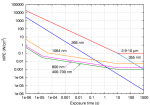Diffused light will cook your eyes , trust me mine are toast !!
I agree with you when pointing to a wall , i just mean when pointing to sky at night ,,,, ( raise the hand and strength as far as possible
However , i agree with you , and i don't play 445nm laser without eye protector ...
So for 1st floor , take care ! at least we don't do the same thing like you !






